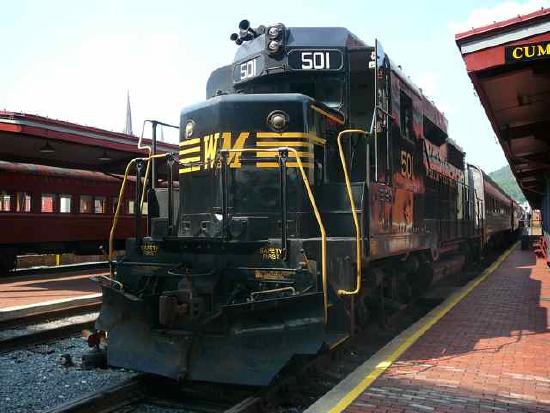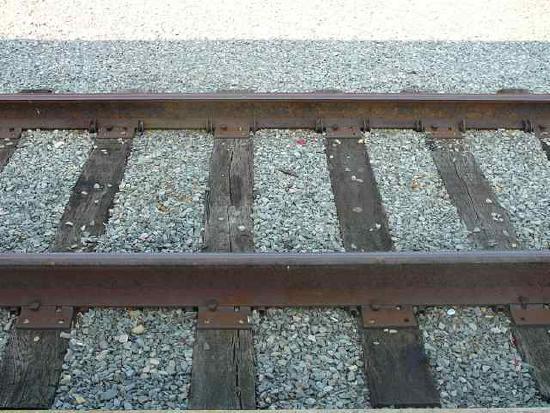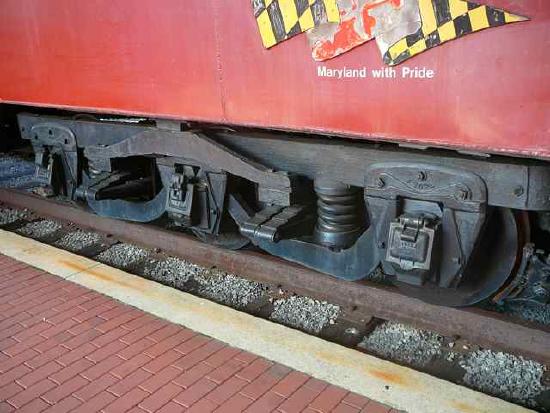11.3: Trains, trains, trains
- Page ID
- 43048
Dynamics of our railway system

The train as we understand it today consists of a locomotive (though not necessarily) and as many as 150 cars to transport either people or freight. Locomotives in a train system have a number of advantages such as replacement so that the train as a whole can still go on if the engine fails. When locomotives become obsolete the rest of the train system can still be used saving money.
Advantages:
- Energy efficient compared to cars/trucks
- Minimal Land Use
- Low air and noise pollution
- High safety record compared to cars/trucks
- Moderate cost of service
- Flexibility: using different locomotives depending on conditions
- Can change out obsolete or broken locomotives without having to replace the whole system
- Special trains can plow snow, can be used in military campaigns (armored with some having gun mounts or carrying missiles), extra cushioned (usually air) train cars for transport of extremely fragile items, NASA railroad (stopped operating for a small period of time when the shuttle program was mothballed) with specialized trains for heavy loads, and...well why don't you all look up more special trains...except...
- Some special trains also have special tracks so that they can go up mountains which are near impossible for trucks and cars at a sustain rate
| Cog train at Pikes Peak, CO. A cog train can travel up grades greater than 10%. The Pikes Peak Cog Train's greatest ascent is 25% grade. A new cog train is to be completed sometime in 2021. |
Disadvantages:
- Not as flexible as an automobile's ability to go where you want (obviously; note you don't need to drive your car on a road)
- Not private (not good for social distancing - spread of disease easier; this is true of airplanes as well)
- However trains would be easier to design for some social distancing than airplanes
- Windows can be opened on trains (at least slow moving ones)
To get trains to go faster might not be what you think. Most trains with current technology (with slight mods) can go very very fast (>500km/hr). It is passenger comfort and other issues that keep the trains from going fast. Here is some things that are done to improve speed.
- Tilting technology: Internally tilt train for comfort
- Increase radius of curvature of track (same as above)
- Deeper ballast
- More sleepers (ties) using concrete (and maybe steel)
- Heavy rail
- Better track alignment (spend the extra money to improve what is alright)
- Large diameter tunnels (for less air pressure)
"Railways" were actually created in ancient times (Greece and Rome) with stone rail roads for transporting large items such as boats to prevent them from leaving the path. These eventually lead to wood rails and then in the 1700s iron rails. However these railways could not be effectively used for trains that have locomotives.
The first railway lines in the United States were laid by Charles Carroll (signer of the Declaration of Independence) in 1828 in Baltimore starting what was known at the Baltimore & Ohio Rail Road (B & O, think Monopoly). The first stone is still on display at the "Birthplace of American Railroading" at the B & O Railroad Museum.
 |
 |
 |
| Western Maryland Scenic Railroad train in Cumberland, MD. | Classic I-beam structure with classic ties (sleepers) that are made of wood (for the Acela, in the picture on top, the ties are made of concrete). | Undercarriage of a train in Cumberland, MD. |
The first trains on the B & O railroad (and other railways in the United States) where pulled by horses, not locomotives because of the sharp curves (locomotives of the time could not take sharp curves). Interestingly there were even some initial trains that were powered by sails. Sails are practical on land and on sea, but would have never been practical for balloon flight (going back to history lesson 1) which necessitated the invention of the heavier-than-air airplane. The steam locomotive made all those initial trains become a historical footnote.
Locomotives were first developed between 1802 to 1804 by Richard Trevithick as a steam locomotive. The first non-steam locomotives were developed between 1890 to 1920 though the steam locomotive was dominant until the 1950s. Interestingly the first electric locomotives were also developed between 1890 to 1920. Many companies were involved in development of different locomotives and there never was a major lack of funding to develop locomotives and railroads until the advent of the automobile and trucks. However, recently environmental considerations have again made development of locomotives a well funded activity once again.
The modern locomotive involves many different engineering disciplines. The most obvious, of course, is mechanical engineering with the engines, bogies, wheels, brakes, vibration control, etc. Civil engineering (or railway civil engineering) would deal with the railway itself...the track, stations, etc. Less obvious are electrical engineering and computer engineering (monitoring systems including drones), chemical engineering (fuels from petrol to hydrogen and sanitation), and system engineering to make sure all of these systems work together. While traditionally trains are viewed as a mechanical or civil engineering career this is no longer the case.
Some sites of interest:
Progress Rail -- One of the largest builders of locomotives (EMD is incorporated into this Caterpillar company)
Bombardier -- Very large Canadian airplane and train company; builder of the Acela Express (with help from some others including TVG)
Association of American Railroads - public policy organization for railroads in the United States
Wabtec corporation -- Parts for many transportation systems but mostly locomotives
Railway City (Wabtex) -- Clickable railcity that students can get a better idea of all the engineering that goes into the railway...COOL!
MotivePower -- A Wabtec company that builds locomotives (The local MARC system has purchased 26 advanced locomotives [MPXpress] from this company)
Norfolk Southern - one of oldest rail system in United States
Baltimore & Ohio Railroad Museum - B&O railroad museum (B&O oldest common carrier railroad system in the United States)
Trains.com -- Magazine on trains
Trainweb.org -- Hosting service for train systems (lots of small operations)
MARC -- Maryland's local train system
VRE -- Northern Virginia's local train system: cross-over agreement with MARC
MetroRail -- Washington D.C.'s subway rail system
Amtrak -- Rather large railway system in the United States; not the only one though
Amtrak's Acela Express -- Currently the fastest train in the USA (Boston to Washington D.C. in the so-called Northeastern corridor)
Amtrak's Acela Express from Wikipedia
References:
- Handbook of Railway Vehicle Dynamics, ed. Simon Iwnicki, CRC Press, New York (2006). This book is not a train enthusiast book but a true engineering book (familiarity with engineering and calculus is required).
- EMD Locomotives, Brain Solomon, Voyageur Press, St. Paul, MN (2006).
- Baltimore & Ohio Railroad Museum, http://www.borail.org
- Railway Technologies Laboratory, https://cvess.me.vt.edu/labs/rtl.html

